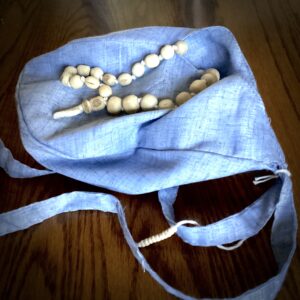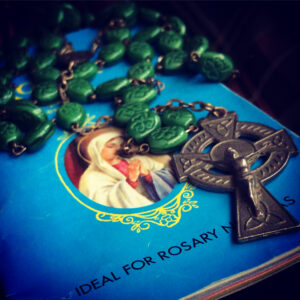“Ram naam karne se sab pura hojata hai.”
“Repeat the Name of God, and everything else is accomplished.”
– Neem Karoli Baba
 What Is Japa?
What Is Japa?
Japa is a word that comes to us from Sanskrit, meaning “to mutter repetitions.” In early Vedic holy books, it was used in reference to repeating scripture verses, or incantations or the name of a deity.
When we do silent mantra meditation, that is essentially a sort of japa practice, as we repeat the mantra to ourselves silently. But most of the time, when someone uses the term nowadays, especially in the West, we mean repetition of a sound, either aloud or silently, while counting the number of repetitions on a japamala (mala, for short). A mala is a string of (usually 108) beads, with a larger centerpiece bead in the middle called the Guru Bead. Sometimes this centerpiece bead will have a tassel or other ornamentation.
Malas (much like Catholic Rosaries) can be made of a wide variety of materials. Some are wooden, some made from seeds or stones or even gems, and some truly beautiful ones are made with no beads at all, using knots in the twine or cord instead of beads. One of the pleasures of practice is to find a mala that suits one’s own temperament, and complements the mantra or name that is being repeated. For instance, I have a Tibetan Bodhi Seed mala that I use when chanting Om Mani Padme Hum. I have a green malachite mala for Green Tara practice. And for the Mahamantra (Hare Krishna, Hare Krishna, Krishna Krishna, Hare Hare, Hare Rama, Hare Rama, Rama Rama, Hare Hare) I use a Tulasi Wood mala and bead bag from the ISKCON store. The range of styles and materials available is truly astounding.
How To Do Japa
Japa practice is relatively simple. We start with the bead next to the Guru Bead between thumb and finger, and say the mantra (either aloud or silently). Then we move to the next bead, proceeding all the way around the mala repeating the mantra until we reach the last bead next to the Guru Bead. That is considered one round of japa.
As you’ll see in the video toward the end of this post, some japa practitioners have more elaborate rules for their practice than others. I try to be respectful of the traditions from whence I received a particular mantra or practice, but there are two rules of thumb that seem to follow across most of the traditions, whether Buddhist or Hindu or sectarian within Buddhism or Hinduism. First of all, it is considered best to keep each mala for its own mantra or practice. Although I admit that early on when I only had one mala I did not observe this rule – and sometimes still, when using a little wrist mala on the go I will chant whatever strikes my fancy that day – I agree that it’s a better practice to have a specific mala for a specific mantra or practice if you can. The energy of the repetitions seems to accumulate, and when you pick up that mala, it puts you in a unique headspace for that practice. Do the best you can with this, though, and don’t beat yourself up if you only have one mala and want to practice a lot of different mantras.
The other rule is one that is easy to follow, and really ought to be followed by everyone, regardless of tradition. Out of respect for God and Guru, we never pass over the Guru Bead. Once we reach that special bead, if we’re going to continue japa we turn the mala and begin counting again in the other direction.
As to what sound you should use as a mantra, I would recommend trying a few different ones to see what resonates most with you. There’s an excellent book on the subject by Lily Cushman called A Little Bit of Mantras. The Hanuman Maui store has it bundled with a small wrist mala for practice. You can also do a Web search for something like “list of mantras” and will find more than enough information to get you started.
If you don’t have a mala, you can still do a simple japa practice. Each of your fingers has three bones in it. Begin by placing your thumb on the bone closest to your hand on your little finger. With each repetition, move past the joint to the next bone, then the next finger, etc. By the time you reach the tip of your index finger, that is twelve repetitions. Nine rounds of that (you can keep track of them with your thumb on three fingers on your other hand) is 108. Prety neat, yeah?
Whatever you use to count, remember that this is a devotional practice. If we just repeat the mantra mechanically to rack up numbers, there may still be something positive to come from our practice. If nothing else, at least we’re not out somewhere misbehaving for a little while. 🙂 But if we try as best we can to turn our attention toward the divine while practicing, to “Remember God” as Neem Karoli Baba put it, then the benefits (to ourselves and our world) will increase many times over.
Why Do Japa?
I put it this way in a recent post about my own daily spiritual practice. Silent mantra meditation (in the style of TM) gets us in touch with the unified field of consciousness from which everything in the universe springs. Devotional chanting (such as Kirtan or Japa) gives us a better sense of our own place in that universe.
TM-style meditation practice is valuable almost beyond estimation in terms of benefits to our health and well being. For me, though, without some sort of devotional practice to compliment it, it misses the larger point. Just as the practice of yoga asanas merely for health benefits ignores (and perhaps distorts) the devotion which is at the heart of the Yoga Sutras, using a mantra merely for benefits such as stress management and enhanced creativity ignores the larger purpose for which we ought to be getting calm and clear in the first place. Surely, we want to be more than just fit and less stressed. At least, I believe that we ought to.
For me, devotional chanting brought my life to an entirely different level of clarity and purpose. Perhaps that would have come in the long run with just the standard twenty minutes twice a day of TM-style meditation anyway, but somehow I don’t think so. Look out there at some of the high-functioning, creative powerhouses who tout TM as a key to their success, and you’ll find at least a few folks who have been practicing for decades, whose lives one might not want to emulate.
Part of the appeal of yoga and TM in the West has been the non-religious, non-sectarian nature of the practices as they are often presented here. That’s fine, as far as it goes, but there is a larger, richer, more beautiful context from which these practices have been ripped. Devotional practices such as japa can help us restore that context, and with it, the wonder and joy and love and healing that our lives and our planet so desperately need.
“The Lord is Awaiting on You All to Awaken and See
By Chanting the Names of the Lord, and You’ll be Free”
– George Harrison
Here’s the video I promised, demonstrating how to chant “Hare Krishna” ISKCON style, from our friends at Hare Krishna TV.
हरी ॐ
Do you chant with a japamala? What’s your favorite mantra? New to the practice and have questions? Hit me with a comment!
 “A Very Powerful Prayer”
“A Very Powerful Prayer”